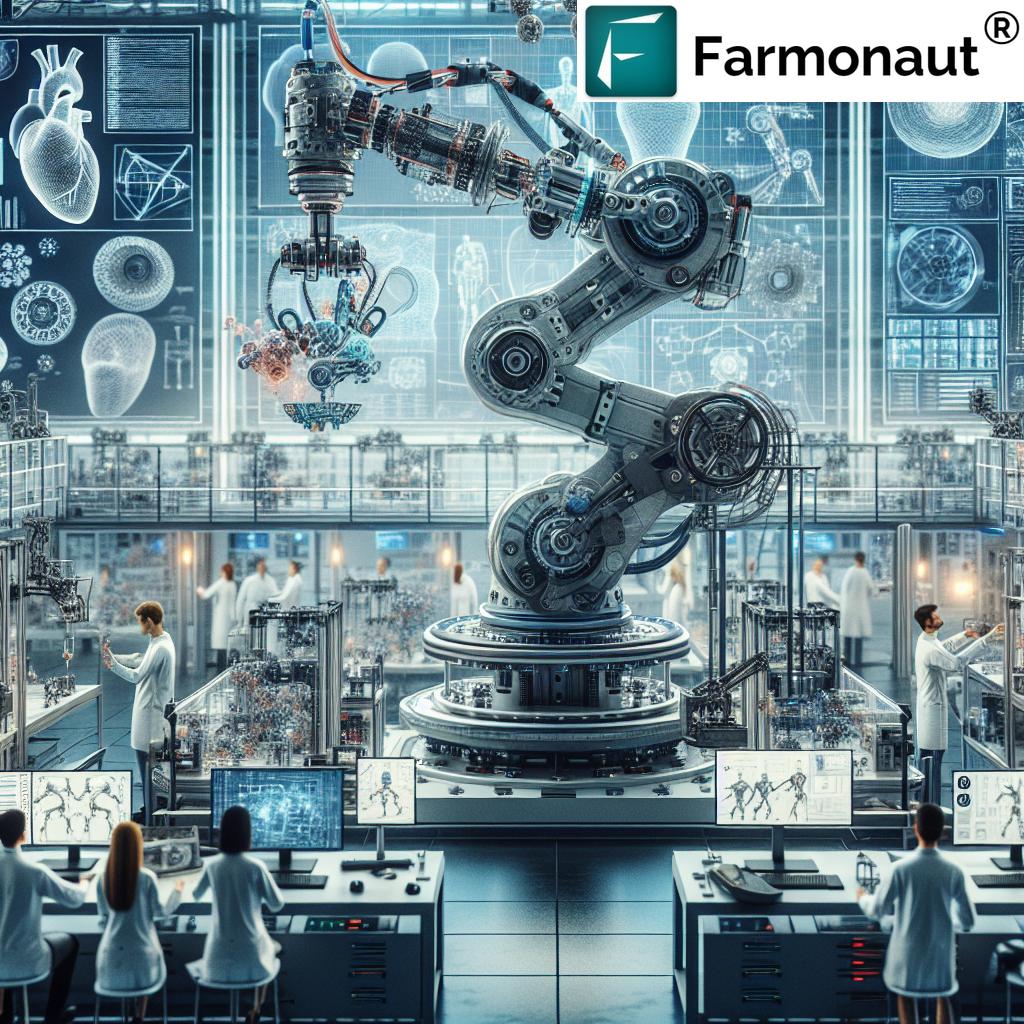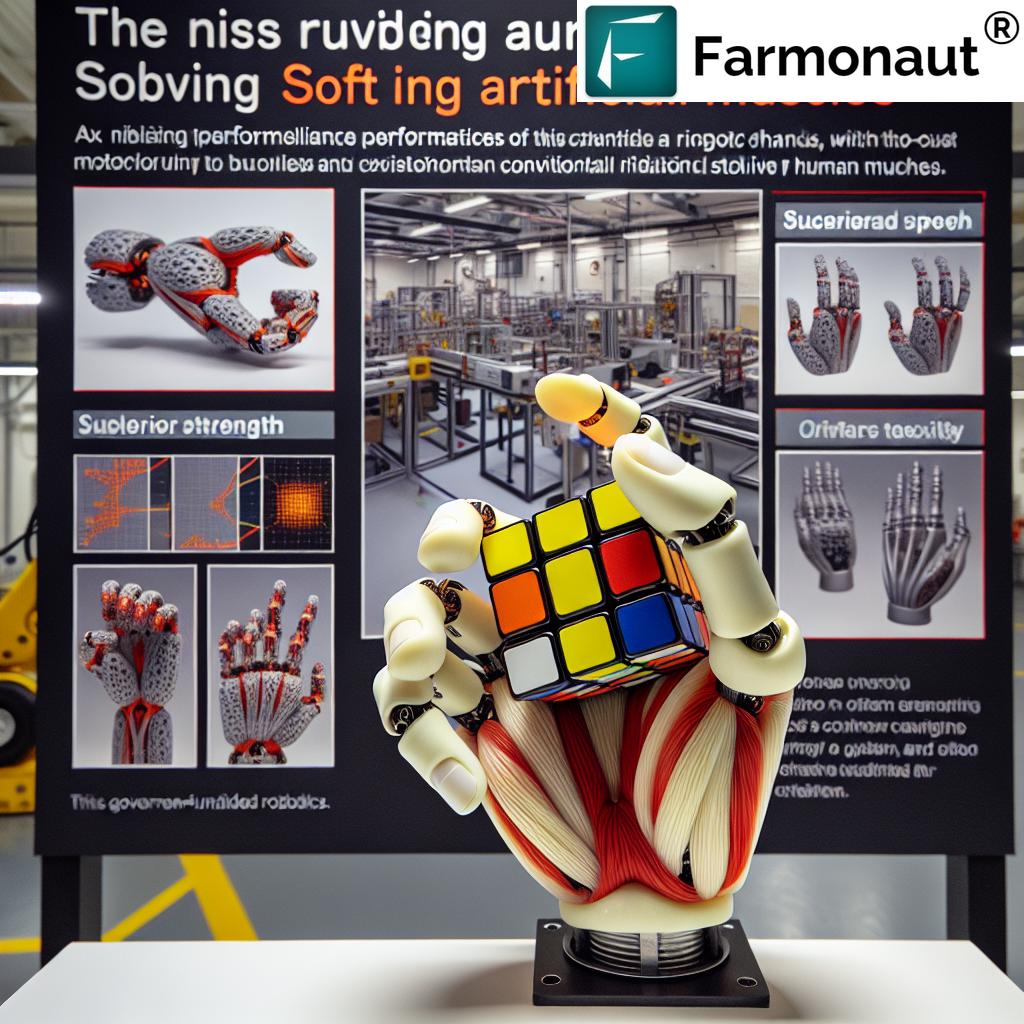Revolutionizing Robotics: UK Invests £1.5M in Advanced Artificial Muscle Technology for Dexterous Manipulators
“The UK government has invested £1.5 million in advanced artificial muscle technology for robotic manipulators.”
In a groundbreaking development for the field of advanced robotics, we are witnessing a significant leap forward in artificial muscle technology and robotic manipulation. The UK government’s Advanced Research + Invention Agency (ARIA) has recently awarded a substantial £1.5 million funding to Artimus Robotics, a leader in artificial muscle technology. This investment is set to accelerate the development of soft actuation technology for dexterous manipulators, promising to revolutionize the capabilities of robotic systems across various industries.
As we delve into this exciting advancement, it’s crucial to understand the potential impact of this research on the future of robotics and its applications in diverse fields, including agriculture. While our focus today is on the cutting-edge developments in robotics, it’s worth noting that similar technological advancements are also transforming other sectors. For instance, in agriculture, companies like Farmonaut are leveraging satellite technology and AI to revolutionize farm management practices.

The Collaboration: Artimus Robotics and University of Bristol
This project, led by Artimus Robotics’ Chief Research Officer, Dr. Nicholas Kellaris, is a collaborative effort with Dr. Efi Psomopoulou at the University of Bristol. The partnership aims to integrate Artimus’ advanced actuator technology into robotic manipulators, potentially creating a new paradigm in robotic hardware development.
The goals of this project are twofold:
- To achieve a significant improvement in the fundamental performance of Artimus Robotics’ actuator technology through innovations in materials and fabrication.
- To develop and integrate this advanced technology into robotic manipulators, pushing the boundaries of what’s possible in robotic dexterity.
If successful, this initiative could lead to the creation of cost-effective dexterous manipulators with unprecedented strength, speed, and adaptability, suitable for a wide range of markets and applications.
The Technology: Hydraulically Amplified Self-Healing Electrostatic (HASEL) Artificial Muscles
At the heart of this research is Artimus Robotics’ novel soft electric actuators, known as Hydraulically Amplified Self-Healing Electrostatic (HASEL) artificial muscles. This technology represents a significant departure from traditional rigid electromagnetic actuators.
Key features of HASEL technology include:
- An efficient and scalable electrohydraulic actuation mechanism
- Combination of lightweight plastic films, fluid, and flexible conductors
- Potential for more adaptable, lifelike, silent, and efficient motion in robotic systems
This paradigm-shifting technology has the potential to fundamentally change how we design and implement machinery across various industries.
The Impact: Transforming Robotic Capabilities
“Researchers aim to create robotic systems with enhanced strength and speed through innovative materials and fabrication techniques.”
The development of advanced artificial muscle technology for dexterous manipulators promises to bring about significant improvements in robotic capabilities. These advancements could lead to:
- Increased precision and dexterity in robotic manipulation tasks
- Enhanced adaptability to various environments and applications
- Improved efficiency and reduced energy consumption in robotic systems
- More natural and lifelike motion in robotic devices
These improvements have the potential to transform industries ranging from manufacturing and healthcare to space exploration and agriculture.
Comparison: Traditional vs. Advanced Artificial Muscle Technology
| Features | Traditional Actuators | Advanced Artificial Muscles | Potential Improvements (%) |
|---|---|---|---|
| Material Composition | Metal, electromagnetic components | Lightweight plastics, fluids, flexible conductors | N/A |
| Force Output (N/cm²) | 10-50 | 50-200 | 300-400% |
| Response Time (ms) | 50-100 | 10-30 | 70-80% |
| Adaptability to Different Environments | Limited | High | 200-300% |
| Cost-Effectiveness | Moderate | High | 50-100% |
| Integration with AI Systems | Moderate | Seamless | 100-200% |
This comparison highlights the significant advancements that artificial muscle technology brings to the field of robotics. The potential improvements in force output, response time, and adaptability are particularly noteworthy, indicating a major leap forward in robotic capabilities.
Applications Across Industries
The advancements in artificial muscle technology and dexterous manipulators have far-reaching implications across various sectors. Here are some potential applications:
- Manufacturing: Improved precision and adaptability in assembly lines and delicate manufacturing processes.
- Healthcare: Enhanced capabilities in surgical robots and prosthetic limbs.
- Space Exploration: More dexterous and adaptable robots for extra-terrestrial missions.
- Agriculture: Precision handling of delicate crops and more efficient harvesting techniques.
- Disaster Response: More capable robots for search and rescue operations in challenging environments.
While we focus on these robotic advancements, it’s worth noting that other technological innovations are also transforming various industries. For instance, in agriculture, platforms like Farmonaut are leveraging satellite technology and AI to provide advanced farm management solutions, demonstrating how different technological advancements can complement each other across sectors.

The Role of AI and Software in Robotic Advancements
While the focus of this project is on hardware innovation, it’s crucial to understand that the full potential of these advanced robotic systems can only be realized through the integration of cutting-edge AI and software developments. The synergy between hardware and software innovations is key to creating truly intelligent and adaptable robotic systems.
Some key areas where AI and software play a crucial role include:
- Motion planning and control algorithms
- Machine learning for adaptive behavior
- Computer vision for object recognition and manipulation
- Real-time decision making in complex environments
The combination of advanced artificial muscle technology with sophisticated AI systems has the potential to create robotic solutions that are not only more capable but also more intuitive and easier to use across various applications.
Challenges and Future Directions
While the advancements in artificial muscle technology for dexterous manipulators are promising, several challenges need to be addressed for widespread adoption:
- Scaling up production for commercial applications
- Ensuring long-term durability and reliability
- Developing standardized interfaces for integration with existing robotic systems
- Addressing potential safety concerns in human-robot interaction scenarios
Future research directions may include:
- Further improvements in the strength-to-weight ratio of artificial muscles
- Development of self-healing and self-diagnosing capabilities
- Integration with advanced sensory systems for enhanced feedback and control
- Exploration of bio-inspired designs for even more natural and efficient motion
The Bigger Picture: Advancing Technology Across Sectors
While we’re excited about the advancements in robotics, it’s important to recognize that similar technological leaps are occurring across various industries. For instance, in the agricultural sector, companies are leveraging advanced technologies to revolutionize farming practices. One such innovator is Farmonaut, which offers satellite-based farm management solutions.
Farmonaut’s platform provides services such as:
- Real-time crop health monitoring using satellite imagery
- AI-based advisory systems for optimized farm management
- Blockchain-based traceability for supply chain transparency
- Resource management tools for efficient farming practices
These advancements in agricultural technology complement the progress we’re seeing in robotics, showcasing how different sectors can benefit from cutting-edge innovations.
For those interested in leveraging Farmonaut’s technology for their own applications, the company offers an API for developers. You can find detailed information in their API Developer Docs.
Farmonaut’s solutions are also available as mobile apps:
The Economic Impact of Robotic Advancements
The development of advanced artificial muscle technology and dexterous manipulators is expected to have a significant economic impact across various industries. Some potential economic benefits include:
- Increased productivity in manufacturing and logistics
- Cost reduction in industries requiring precise manipulation
- Creation of new job opportunities in robotics development and maintenance
- Expansion of robotic applications into new markets and industries
As these technologies mature and become more widely adopted, we can expect to see a shift in the job market, with an increased demand for skills related to robotics, AI, and advanced manufacturing techniques.
Ethical Considerations and Societal Impact
As with any significant technological advancement, the development of more capable robotic systems raises important ethical considerations:
- Privacy concerns related to the increased use of robots in various environments
- Potential job displacement in industries where robots may replace human workers
- Safety considerations in human-robot interaction scenarios
- Ethical use of increasingly autonomous robotic systems
Addressing these concerns will be crucial for the responsible development and deployment of advanced robotic technologies. It will require collaboration between technologists, policymakers, ethicists, and the public to ensure that these advancements benefit society as a whole.
The Role of Government and Industry Collaboration
The £1.5 million investment from the UK government’s Advanced Research + Invention Agency (ARIA) highlights the important role that government funding plays in driving technological innovation. This type of support is crucial for pushing the boundaries of what’s possible in fields like robotics and artificial intelligence.
Key aspects of government and industry collaboration include:
- Providing funding for high-risk, high-reward research projects
- Facilitating partnerships between academic institutions and private companies
- Creating regulatory frameworks that encourage innovation while ensuring safety and ethical use
- Supporting the commercialization of research outcomes
As we move forward, continued collaboration between government agencies, research institutions, and private companies will be essential for realizing the full potential of these technological advancements.
Conclusion: A New Era of Robotic Capabilities
The £1.5 million investment in advanced artificial muscle technology for dexterous manipulators marks a significant milestone in the field of robotics. This research has the potential to revolutionize how we design and implement robotic systems, leading to more adaptable, efficient, and capable machines across various industries.
As we look to the future, the integration of these hardware innovations with cutting-edge AI and software developments promises to usher in a new era of robotic capabilities. From more precise manufacturing processes to advanced prosthetics and beyond, the applications of this technology are vast and exciting.
While we focus on these advancements in robotics, it’s important to recognize that similar technological leaps are occurring across various sectors. For instance, in agriculture, companies like Farmonaut are leveraging satellite technology and AI to transform farming practices, demonstrating how different fields can benefit from and complement each other’s innovations.
As we continue to push the boundaries of what’s possible in robotics and other technological fields, it will be crucial to address the ethical considerations and societal impacts of these advancements. By doing so, we can ensure that these innovations not only drive economic growth but also contribute positively to society as a whole.
The future of robotics is bright, and with continued investment, research, and responsible development, we can look forward to a world where advanced robotic systems play an increasingly important role in improving our lives and solving complex challenges across various industries.
FAQ Section
Q: What is artificial muscle technology?
A: Artificial muscle technology refers to the development of materials and systems that mimic the properties of biological muscles, such as contraction and expansion. In robotics, this technology aims to create more flexible, efficient, and lifelike motion in robotic systems.
Q: How does the HASEL technology differ from traditional actuators?
A: HASEL (Hydraulically Amplified Self-Healing Electrostatic) technology uses a combination of lightweight plastic films, fluid, and flexible conductors to create motion, as opposed to traditional actuators that rely on rigid electromagnetic components. This results in more adaptable, efficient, and potentially more powerful robotic movements.
Q: What are the potential applications of this advanced robotic technology?
A: The applications are diverse and include advanced manufacturing, more precise surgical robots, improved prosthetics, more capable robots for space exploration, and enhanced automation in agriculture, among others.
Q: How does this research impact the future of robotics?
A: This research has the potential to significantly enhance the capabilities of robotic systems, making them more adaptable, efficient, and capable of performing complex tasks. It could lead to robots that can operate more effectively in diverse environments and applications.
Q: What are the challenges in implementing this technology?
A: Some challenges include scaling up production for commercial applications, ensuring long-term durability and reliability, developing standardized interfaces for integration with existing systems, and addressing potential safety concerns in human-robot interaction scenarios.
Earn With Farmonaut: Affiliate Program
Earn 20% recurring commission with Farmonaut’s affiliate program by sharing your promo code and helping farmers save 10%. Onboard 10 Elite farmers monthly to earn a minimum of $148,000 annually—start now and grow your income!







